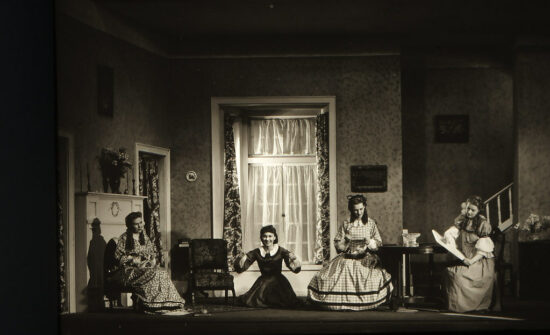Plot and Storyline
“Little Women” by Louisa May Alcott is a beloved coming-of-age novel published in 1868. Set in Concord, Massachusetts, during the Civil War era, the story follows the lives of the four March sisters—Meg, Jo, Beth, and Amy—as they navigate the challenges and joys of adolescence and early adulthood.
The novel begins with the sisters’ struggles during their father’s absence at war. Marmee, the mother of the March family, is a strong-willed and compassionate woman. Despite their limited resources, the sisters find solace in their close bond and creativity.
Meg, the eldest sister, is responsible and yearns for a traditional life filled with love and stability. Jo, the second-eldest, is a tomboy with a fiery spirit and a passion for writing. Beth, a gentle and selfless soul, finds joy in music but battles with fragile health. The youngest sister, Amy, is artistic and ambitious, often struggling with her desire for beauty and material possessions.
Throughout the novel, the sisters experience personal growth, face societal expectations, and encounter various suitors. Meg falls in love with John Brooke, Laurie’s tutor, and they marry, embracing a simple yet fulfilling life. Jo, initially resistant to romance, forms a deep friendship with Laurie, their wealthy neighbor. However, Jo rejects Laurie’s romantic advances, realizing that they are better suited as friends. Instead, Jo pursues her writing career in New York, where she meets Professor Friedrich Bhaer, a mentor who encourages her literary aspirations.
Meanwhile, Beth’s health continues to decline, and she ultimately succumbs to scarlet fever, leaving a profound impact on her family. Amy, initially jealous of Jo’s independence, accompanies Aunt March to Europe, where she develops her artistic talents and encounters Laurie once again. They fall in love and eventually marry, as Laurie finds happiness with Amy.
The novel explores themes of love, family, sacrifice, and the pursuit of personal dreams. It highlights the importance of female agency and challenges societal expectations placed upon women during that era. The story also emphasizes the power of sisterhood and the value of individuality.
Characters
Louisa May Alcott crafts memorable and relatable characters in “Little Women.” Each sister possesses unique qualities that contribute to the overall narrative.
Meg represents the traditional woman of her time, seeking love, marriage, and a stable home. Her character development revolves around finding contentment in her modest life and embracing the roles of wife and mother.
Jo, the protagonist, is a fiercely independent and ambitious character. She defies societal norms by rejecting marriage proposals and pursuing a writing career. Jo’s journey is one of self-discovery as she learns to balance her aspirations with the importance of love and family.
Beth embodies kindness, gentleness, and selflessness. Her character serves as a moral compass, teaching the importance of compassion and cherishing life’s simple joys. Her untimely death deeply impacts her family and serves as a reminder of life’s fragility.
Amy undergoes significant growth throughout the novel. Initially portrayed as vain and materialistic, she matures and gains a deeper understanding of life and love. Amy recognizes the value of art and finds her own path to fulfillment.
Marmee, the girls’ mother, is a source of strength and guidance. She instills in her daughters the importance of virtue, empathy, and independence. Marmee’s character represents the ideal mother figure and provides a moral compass for her daughters.
Themes and Symbols
“Little Women” delves into several major themes that resonate with readers across generations.
1. Family and Sisterhood: The novel celebrates the bond of sisterhood and the importance of familial love and support. The March sisters rely on each other during challenging times, and their unity remains a constant source of strength.
2. Gender Roles and Female Agency: Alcott explores the limitations and expectations placed upon women in the 19th century. Through Jo’s character, she challenges societal norms by advocating for female independence, education, and creative pursuits.
3. Coming-of-Age and Self-Discovery: The novel captures the transformative journey from adolescence to adulthood. Each sister grapples with personal growth, identity, and the pursuit of individual dreams.
4. Sacrifice and Generosity: The March sisters embody selflessness and demonstrate the power of sacrificing personal desires for the greater good. Beth’s illness and eventual death highlight the importance of putting the needs of others before oneself.
5. Love and Marriage: “Little Women” explores different forms of love, including familial love, friendship, and romantic love. It analyzes the complexities of relationships and highlights the importance of finding companionship and understanding.
Writing Style
Louisa May Alcott’s writing style is characterized by its simplicity, warmth, and sincerity. The language is accessible, allowing readers to engage with the story and characters on a personal level. Alcott’s use of dialogue adds authenticity and depth to the characters, capturing their distinct personalities and emotions.
Alcott employs various literary techniques throughout the novel. One notable technique is the use of parallelism, where she juxtaposes the sisters’ different experiences and perspectives. This technique emphasizes their individuality while highlighting their shared bond as a family.
The narrative structure of “Little Women” follows a linear timeline, allowing readers to witness the growth and development of the characters over time. Alcott’s careful attention to detail and vivid descriptions create a vivid and immersive reading experience. She expertly balances moments of humour, sentimentality, and introspection, creating a dynamic and engaging narrative.
One example of Alcott’s writing style can be seen in this passage: “Christmas won’t be Christmas without any presents,” grumbled Jo, lying on the rug. “It’s so dreadful to be poor!” sighed Meg, looking down at her old dress. “I don’t think it’s fair for some girls to have plenty of pretty things, and other girls nothing at all,” added little Amy, with an injured sniff.
This passage highlights the simplicity and authenticity of the characters’ voices, allowing readers to empathize with their struggles and desires.
Setting and Atmosphere
“Little Women” is set in Concord, Massachusetts, during the mid-19th century. The historical context of the Civil War and its aftermath provides a backdrop for the story. The domestic setting of the March family home creates a sense of intimacy and warmth, emphasizing the importance of familial relationships.
The atmosphere of the novel is characterized by a combination of tenderness, nostalgia, and optimism. Alcott’s descriptions of the changing seasons, holiday traditions, and everyday moments evoke a sense of familiarity and comfort. The contrasting elements of joy and sorrow contribute to the emotional depth of the story, creating a rich and resonant atmosphere.
Historical, Social, or Political Context
“Little Women” is deeply influenced by the historical, social, and political context of its time. The novel reflects the societal expectations and constraints placed upon women during the 19th century. Alcott portrays the limited opportunities available to women for education and professional pursuits, highlighting the struggles faced by her female characters.
The novel also addresses the impact of the Civil War on families and communities. The absence of Mr. March due to his involvement in the war and the financial hardships faced by the March family reflect the broader consequences of the war on society.
Alcott’s portrayal of the March sisters challenging traditional gender roles and advocating for female independence reflects the emerging women’s rights movement of the time. The novel serves as a critique of the limitations placed upon women and promotes the idea of women’s agency and self-determination.
Impact and Reception
“Little Women” has had a significant impact on literature and continues to resonate with readers worldwide. The novel’s exploration of themes such as family, love, and female empowerment has made it a timeless classic.
Upon its publication, “Little Women” was well-received by readers and critics alike. It quickly gained popularity and became a bestseller. The novel’s relatable characters and universal themes struck a chord with audiences, particularly young women.
Over the years, “Little Women” has been adapted into numerous stage plays, films, and television series, further solidifying its cultural significance. The novel’s enduring popularity can be attributed to its timeless themes, memorable characters, and Alcott’s skillful storytelling.
In conclusion, “Little Women” by Louisa May Alcott is a compelling and heartwarming novel that explores the bonds of sisterhood, the pursuit of personal dreams, and the challenges faced by women in the 19th century. Through its relatable characters, evocative setting, and timeless themes, the novel continues to captivate readers and inspire generations to come.






